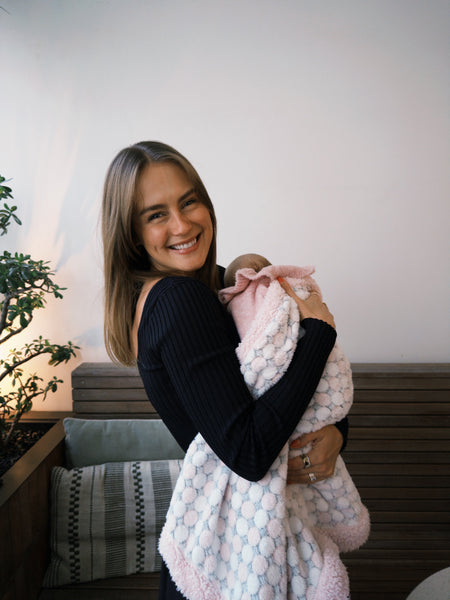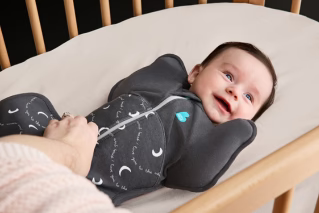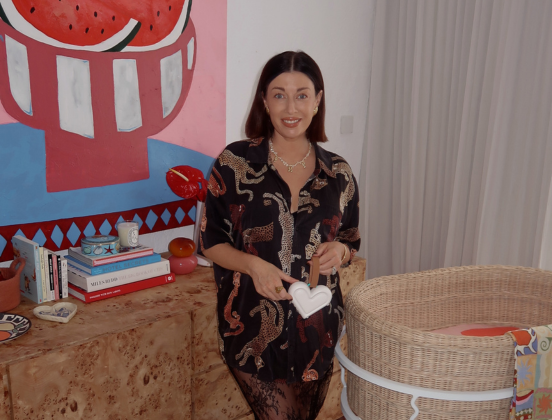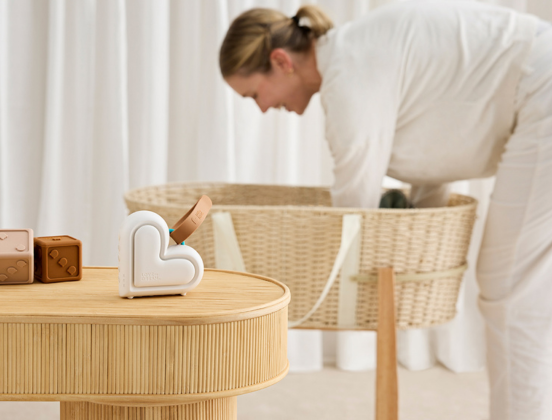Dressing your baby for bed after a bath can be a super relaxing routine that they will love. Having the perfect sleep garment will help them to sleep better, to feel comfortable, and stay warm. Progressing beyond the traditional tightly wrapped swaddle is our Love To Dream™ range of swaddles, including the award-winning SWADDLE UP™. These swaddles allow movement so that your baby can bring their hands to their face for self-soothing. These swaddles also allow movement around the hip area which is supportive for your growing bub.
Some other key considerations when dressing your baby for sleep…
Setting the right room temperature
Having the perfect room temperature will allow your baby to drift off into a relaxing and restful sleep. To keep bub cosy, it is recommended to have the room set at around 20-21 degrees (c). You can then add layers including singlets, jumpsuits, PJs and of course their swaddle or sleep garment. Whatever makes your baby feel super snug and warm.
Choosing the right fabric for sleepwear
Keeping bub super comfortable and cosy is easy with the right fabric. Your swaddle or sleeping garment should be chosen for the season. Fabrics like organic cotton, bamboo and wool not only feel soft to touch, but are durable, sustainable, and warm.
Bamboo as a material is a natural temperature regulator thanks to the tiny gaps between the fibres. Not only is bamboo super soft and silky, but it helps your baby to stay cool and comfortable during warmer temperatures. Bamboo is breathable and absorbent, absorbing up to four times more moisture than cotton! It is a sustainable fabric, kind to the environment and kind to your baby’s skin. LOVE TO DREAM’S range of bamboo swaddles and sleeping garments can be found here.
Cotton is a durable and natural choice of fabric that supports your little one’s delicate skin. Cotton is hypoallergenic and odour-free. It is very low maintenance and naturally sustainable. LOVE TO DREAM’S range of premium organic cotton sleepwear includes swaddles, sleep garments and sleeping bags. Try our organic cotton and Australian Merino Wool blends for warmer wearing nightwear. Cotton provides a soft and smooth feel to the skin, without clinging to the body. And is perfect for that natural yet snuggly sensation.
The wool in LOVE TO DREAM’s sleepwear is the famous Australian Merino Wool. Known for its rich, truly warm and nurturing feel, Australian Merino Wool is organic and luxurious. The lightweight and superfine fibres are spun together to create wool from the thick coats of merino sheep—giving bub the most relaxing and settling sleep.
Dressing baby during summer
When temperatures are between 24-27 degrees, you’ll want to lean towards a lighter swaddle for your baby to wear to bed. Our summer swaddles are perfect for bub on warm summer nights. Remember to adjust room settings when the weather changes. And always keep an eye on your little one’s temperature.
How to know if your baby is too hot?
Flushed cheeks can be the first sign that bub is a little too warm. Also, the nape of their neck being sweaty or moist can indicate being over warm. If they are fussing or unsettled, it could be time for a temperature check. Removing or adding layers can help your baby to be more comfortable.
Dressing baby during winter
For cooler temperatures of between 16-20 degrees, our winter swaddles, available in warm and extra warm ratings, will be perfect for your baby to wear to bed. You’ll want to notice the cues your little one gives when getting them ready for sleep. This will help to determine how many layers they need to keep them warm without making them hot. As a guide, your baby will generally need one extra layer than you do.
How to know if your baby is too cold?
Feeling their torso will give you a good idea if bub is too cold. If their tummy is still warm and they are settled, then they are probably comfortable and warm enough. If they have very cold hands and feet, don’t seem interested in feeding or are irritable, then they could be cold.
Swaddling, sleepwear, and the natural startle reflex
Swaddling provides your newborn baby with the comfort, warmth, and security that helps encourage a deeper sleep. But it also addresses behaviours that may cause your little one to frequently wake.
Have you ever had a dream where you feel like you’re falling, and you jolt awake? Newborns experience something similar called the startle reflex which is an involuntary extension of their arms and legs that interrupts sleep. Swaddling can reduce the startle reflex infants experience by keeping them snug and secure, while also preventing them from instinctively scratching their delicate faces.
The benefits of skin-to-skin contact
Studies have been conducted on the benefits of skin-to-skin contact, a warm bath, and nurturing cuddles. Research discovered that skin-to-skin contact could be beneficial for your baby even up to 3-6 months post birth. Because of these nurturing practices, your baby is more likely to drift into a restful, settled and blissful sleep.
Should you swaddle your baby for sleep?
Swaddling can be a soothing, safe, and secure sleep experience. Responding to your baby’s cues when they are sleeping or awake will ensure they are more comfortable and settled each time. When your baby show signs of starting to roll, it’s time for them to transition to an arms free sleep garment. As they grow and develop, the type of swaddle or sleep garment used for when your baby sleeps will change. If they begin to resist being swaddled or become unsettled when being swaddled, it may be time to move to the next step of their sleep phase. An arms free garment for baby or sleep suit for your toddler might be next.
How to dress a newborn baby for sleep with a swaddle
Step 1: Temperature
Our provides a guide you can use to select the best sleep garment for your baby. Ensuring the room is not too hot or too cold can reduce the risk of SIDS*. Adjust room heaters or air-conditioners, drafts and windows as needed so your baby will sleep soundly.
Step 2: Safety
Avoid loose items or blankets in the cot or bassinet and make sure nothing can come up above your baby’s face to cover their nose or mouth. Remove hanging cords, including electrical and blind cords. Ensure your baby has a firm surface to sleep on; either a cot, bassinet, or portable crib with a tight fitted sheet.
Step 3: Choose Your Swaddle
You want to ensure your baby is not swaddled too tight and full hip flexion is possible as this is recommended for healthy hip development. You need to use a sleep garment that works well for your baby, from when they are a newborn, to when they begin to roll and will need to transition to an ARMS UP swaddle (about 4 – 6 months), right through to when they are able to walk and are on the move.
Step 4: Time to swaddle
Lay your swaddle down on a flat, safe surface then gently place your baby on top. Zip up the swaddle to ensure there are no loose ends or open parts, with their arms inside the wings. Now place your baby down to rest in their cot. It’s important to have your baby sleep on their back. Do not place them on their sides or tummies. This is for the prevention of SIDS*.
Taking special care with the tips above should allow you to perfect the technique of swaddling your baby. With practice, you'll master your own swaddling routine that works for you both.





















